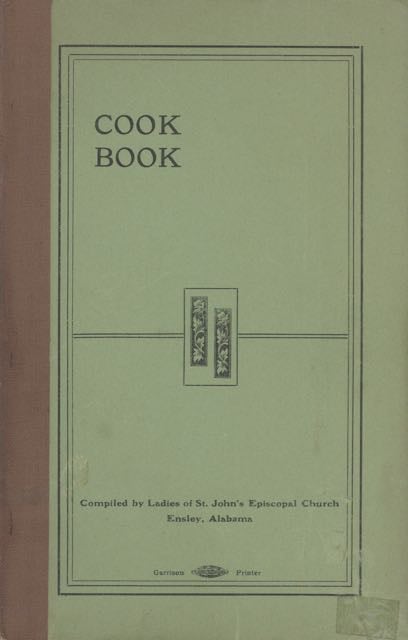
Cook Book. Compiled by ladies of St. John's Episcopal Church, Ensley, Alabama.
Ensley, Alabama: [The Church; Printed by] Garrison Printer, [between 1909 and 1915].
Octavo (21 x 13.5 cm.), 89, [i] pages. Advertisements. Index and “Index of advertisements.” Date of publication estimated from external evidence. Evident FIRST EDITION. A church cookbook from a once independent municipality at the moment of its absorption into greater Birmingham. Nearly three hundred recipes, some of them attributed; including: English Currant Bread, Poached Eggs with Creamed Celery, Fried Okra with Onions, Artichoke à la Barigoile (i.e., Barigoule), Creamed Parsnips, Cherry Salad, Savory Custard, Prune Trifle, Chelee Sauce, Rhubarb Relish, Scuppernong Wine, Coffee Jelly, Watermelon Preserves. ~ Located at the southern edge of the Pratt Coal Seam, Ensley was a planned industrial city, built on land acquired by Enoch Ensley (1832-1891) to provide housing as well as communal and commercial infrastructure for workers employed in the coal and iron ore mines of the Tennessee Coal, Iron & Railroad Company. Residents’ experience in self-governance was short: the city was incorporated in February 1899 but annexed by Birmingham on the first day of 1910. Opposition to the takeover was vigorous – a mock funeral was held and a tombstone laid to commemorate the “euthanized” city – such that the persistence of the community’s independent identity works against clarity regarding the appearance of the St. John’s Cook Book. Advertisements for two theaters equipped to exhibit silent films place the range of dates across the annexation divide: both – that for the Belle Theatre on page 2 and that for the Franklin Theatre on page 28 – announce adherence to guidelines set forth by the National Board of Censorship, a name (for what became the National Review Board) in use only between late 1909 and 1915. ~ The history of Episcopalians in Alabama cannot be separated from the history of advocacy for slavery, nor from the influential tenure of the Confederate episcopate of Richard Hooker Wilmer (1816-1900), an ardent proponent of secession. Unlike Methodists, Baptists, and Presbyterians, Episcopalians did not divide over issues surrounding abolition. While their numbers declined in the later nineteenth century – Wilmer, though under house arrest for demonstrations of hostility against the United States president, was still permitted to serve as bishop – they retained the loyalty of landholders and industrialists. Thus the upper echelons of Ensley grew sufficiently to merit the establishment of a parish, which was admitted into the Diocese in 1898, just before formal incorporation of the city. Images of the church for which funds were raised by the Ladies of St. John’s are not listed among the archival holdings now deposited at the Birmingham Public Library. (The brick complex that stands at the site today, on Ensley West Avenue, was built in 1951. The parish having dissolved in 2000, this building was listed for sale in 2016.) ~ One abrasion along fore-edge of text block. Stapled in publisher’s green wrappers, titled in black, over brown cloth. Some soiling and a small tape repair to lower edge of front wrapper. Duplicate front wrapper bound in. Scarce. [OCLC locates one copy; Cather, Fifty Alabama Cookbooks 20; not in Cook, Brown or Cagle].
Price: $350.00
